Abstract
The Caenorhabditis elegans sex determination gene tra-3 is required for the correct sexual development of the soma and germ line in hermaphrodites, while being fully dispensable in males. Genetic analysis of tra-3 has suggested that its product may act as a potentiator of another sex determination gene, tra-2. Molecular analysis reported here reveals that the predicted tra-3 gene product is a member of the calpain family of calcium-regulated cytosolic proteases, though it lacks the calcium binding regulatory domain. Calpains are regulatory processing proteases, exhibiting marked substrate specificity, and mutations in the p94 isoform underlie the human hereditary condition limb-girdle muscular dystrophy type 2A. The molecular identity of TRA-3 is consistent with previous genetic analysis which suggested that tra-3 plays a very selective modulatory role and is required in very small amounts. Based on these observations and new genetic data, we suggest a refinement of the position of tra-3 within the sex determination cascade and discuss possible mechanisms of action for the TRA-3 protein.
Full text
PDF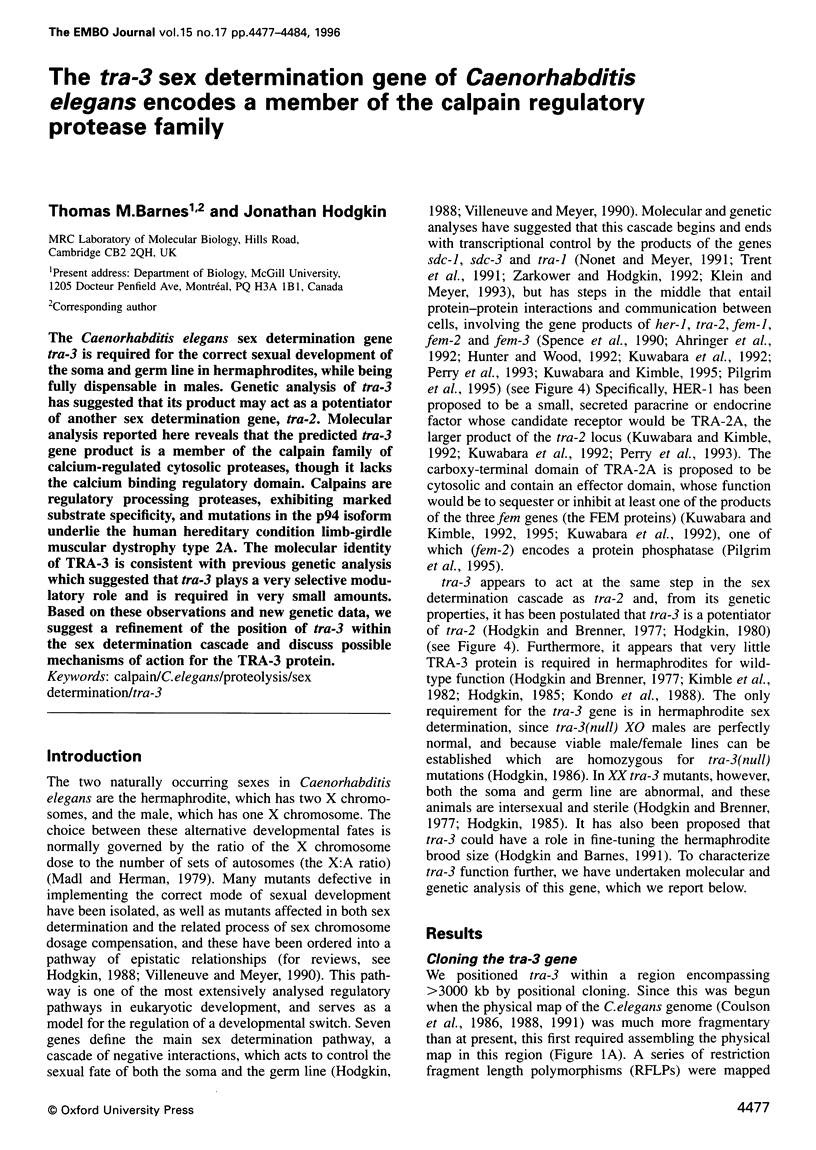
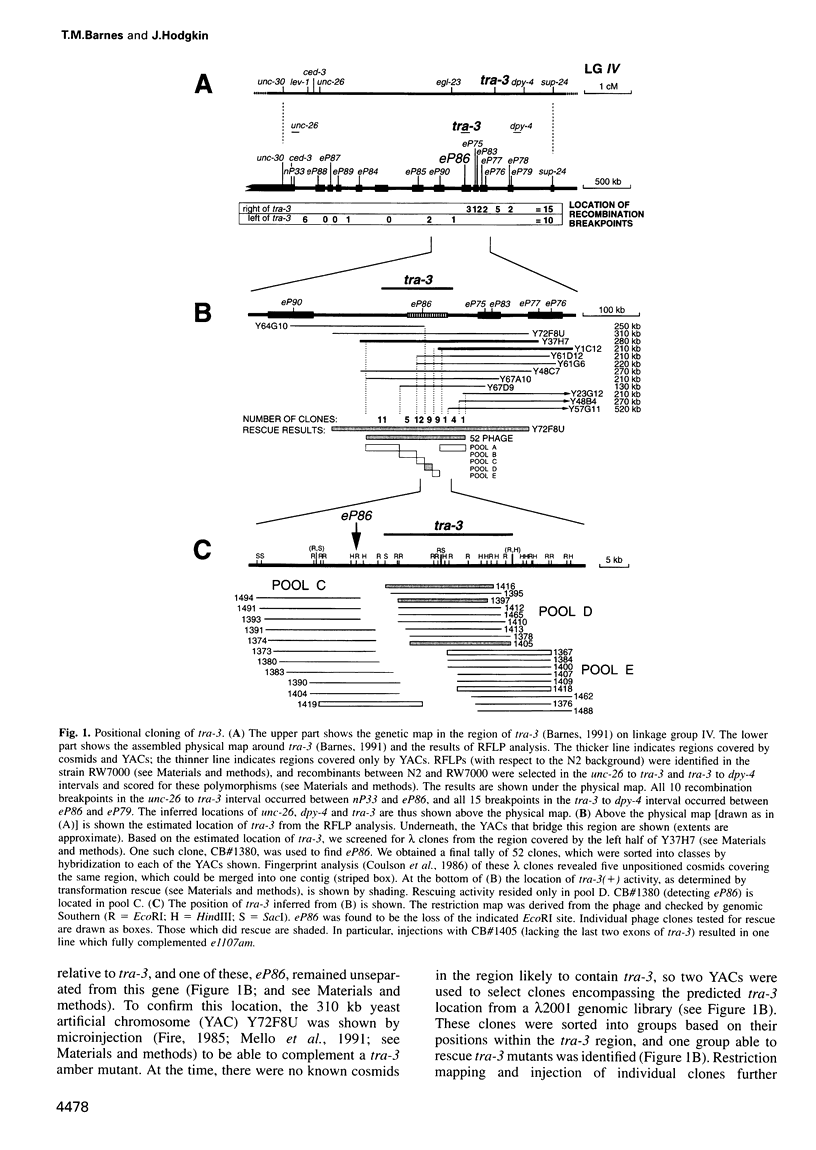
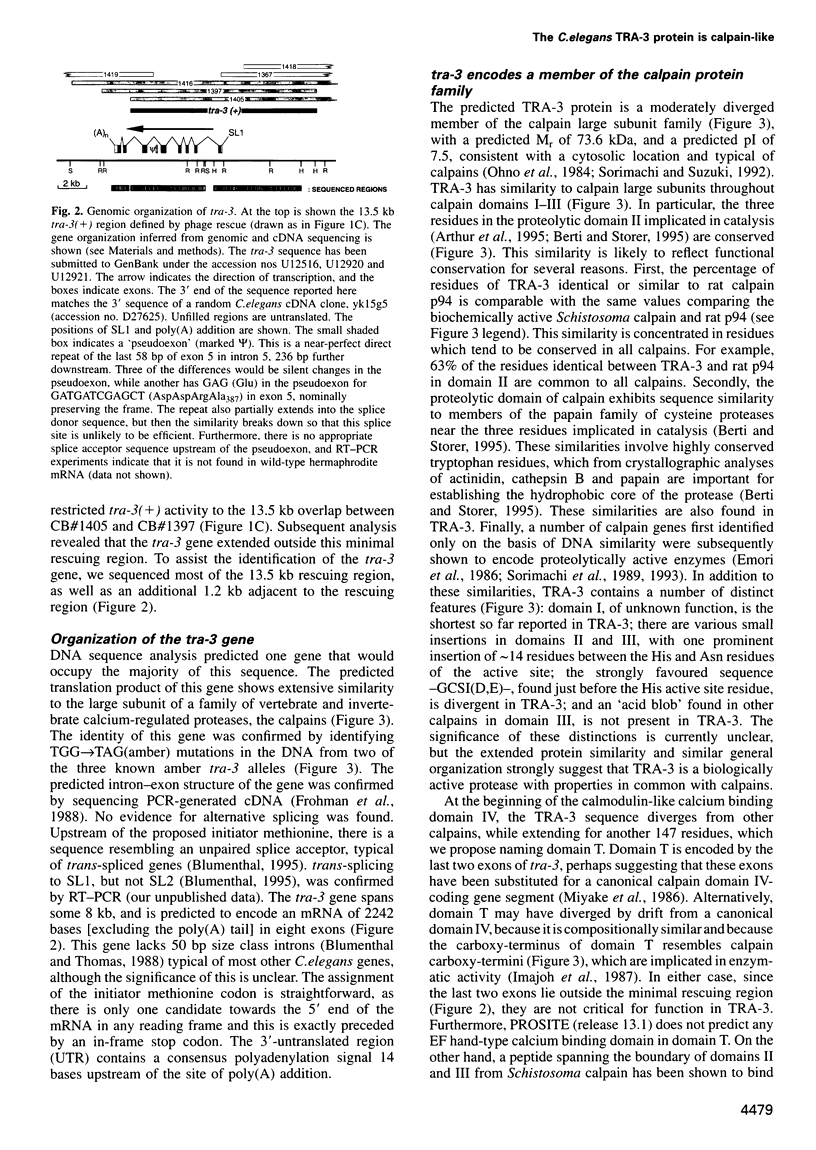
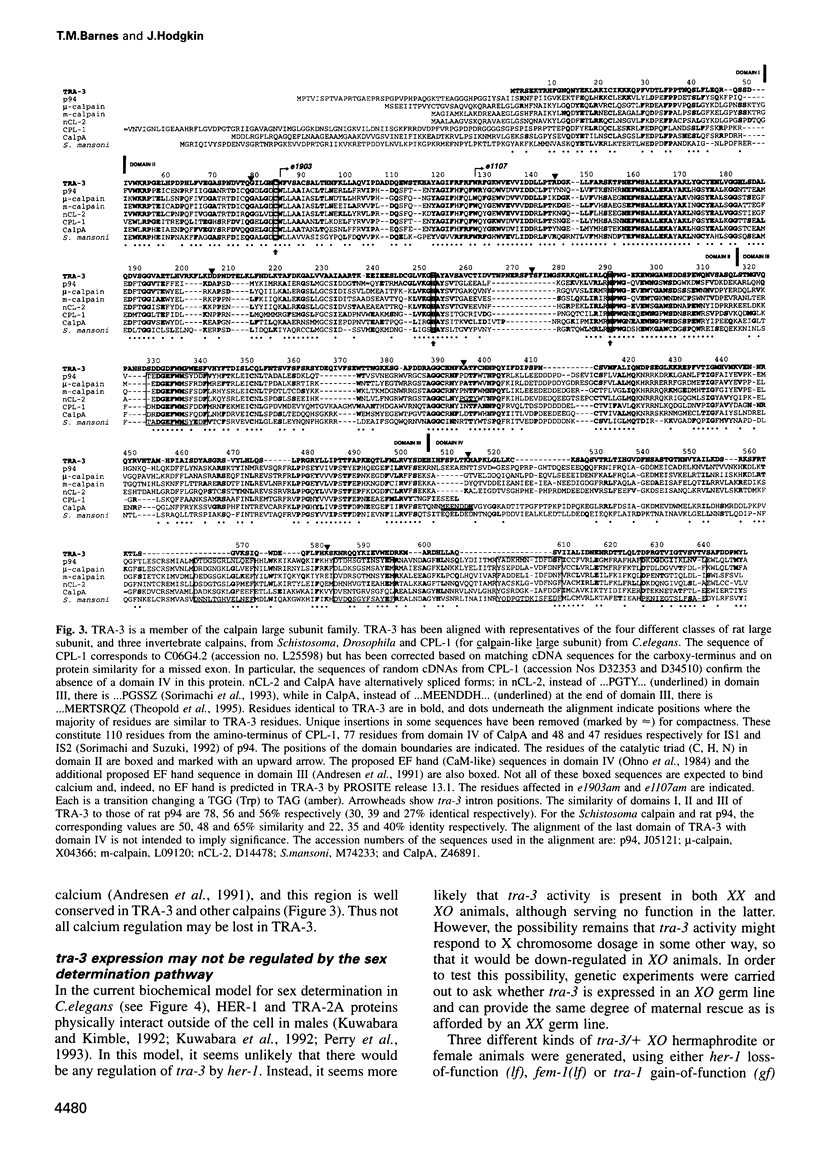

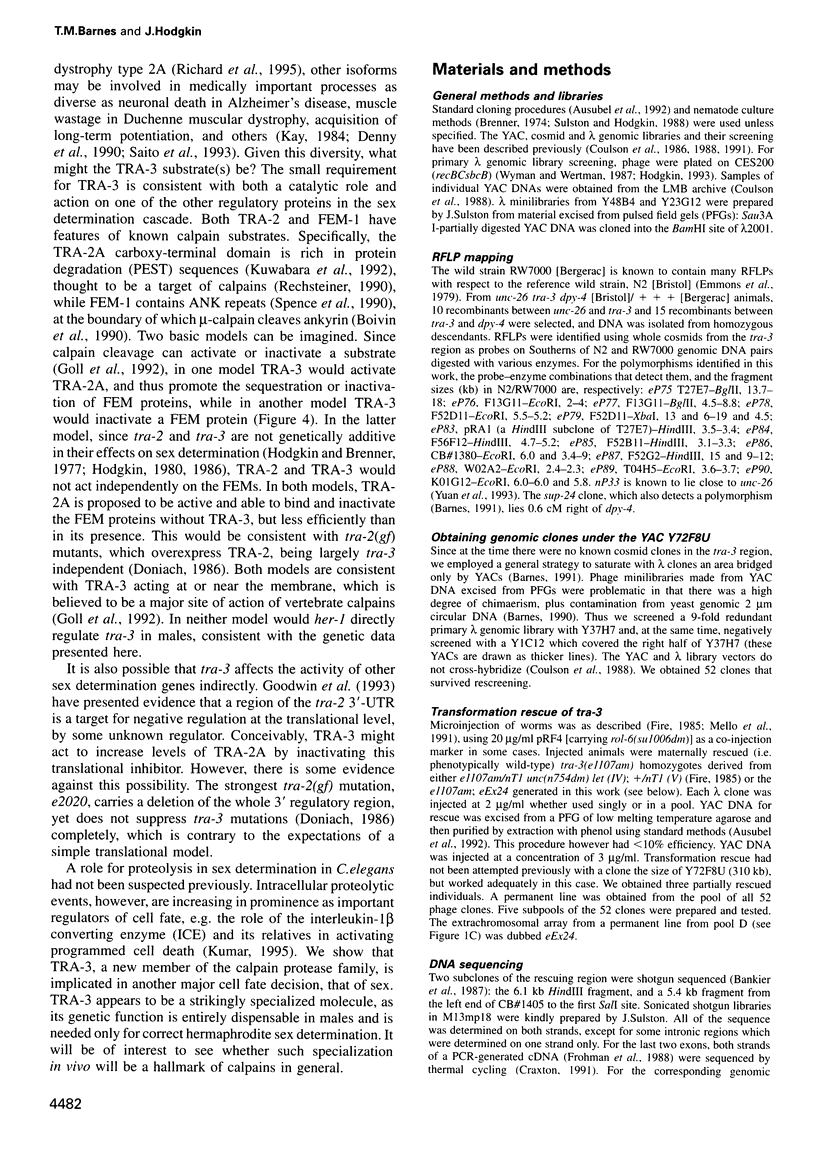
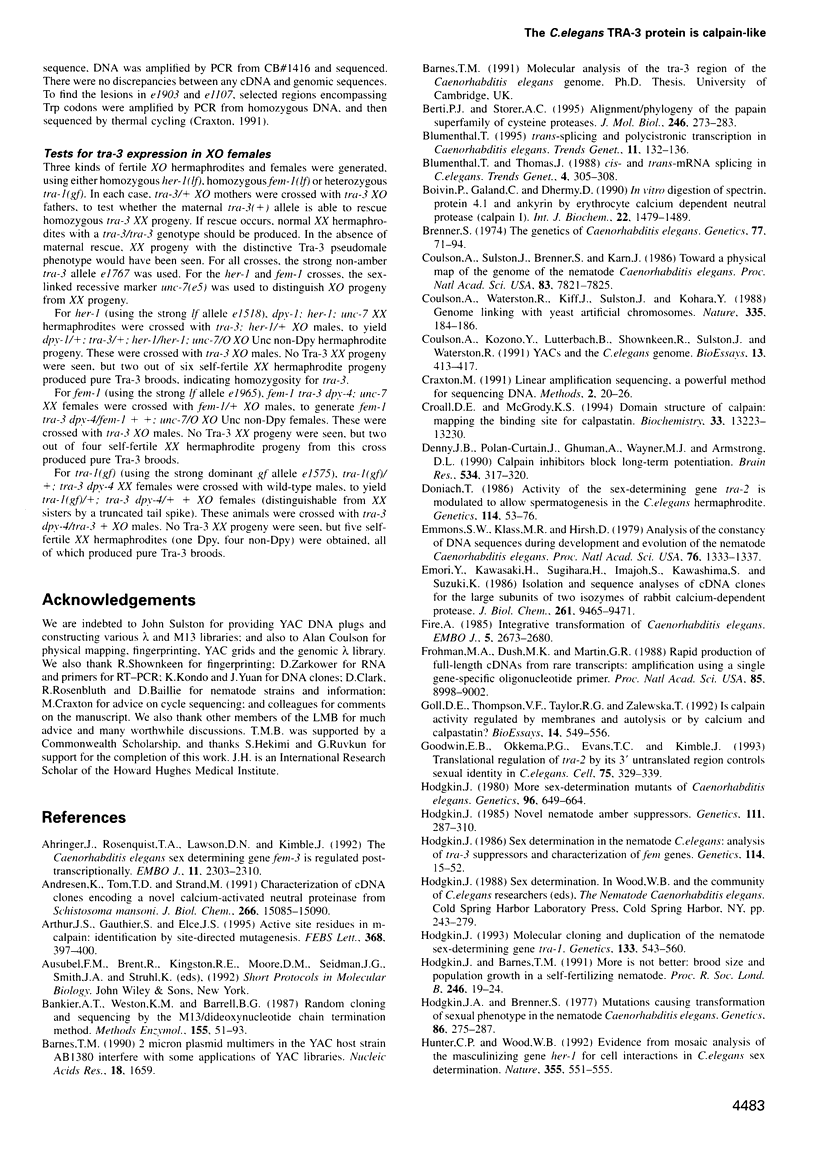
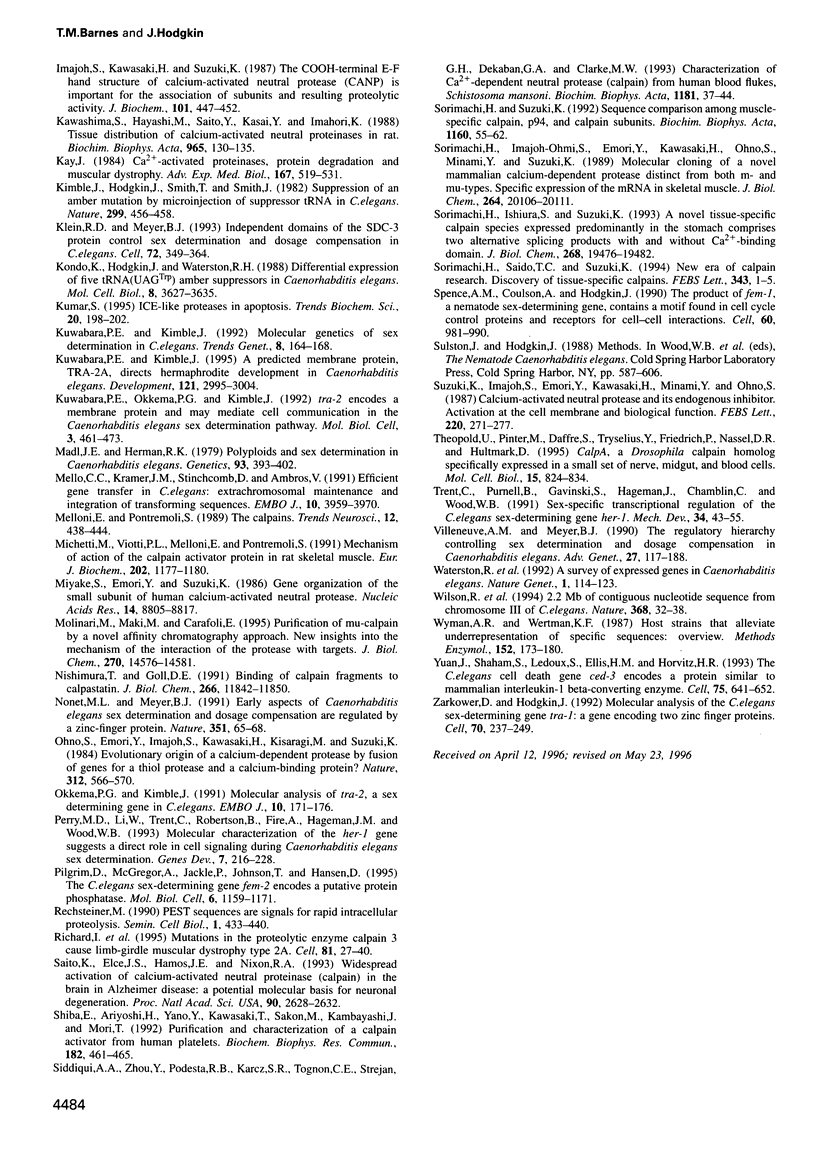
Selected References
These references are in PubMed. This may not be the complete list of references from this article.
- Ahringer J., Rosenquist T. A., Lawson D. N., Kimble J. The Caenorhabditis elegans sex determining gene fem-3 is regulated post-transcriptionally. EMBO J. 1992 Jun;11(6):2303–2310. doi: 10.1002/j.1460-2075.1992.tb05289.x. [DOI] [PMC free article] [PubMed] [Google Scholar]
- Andresen K., Tom T. D., Strand M. Characterization of cDNA clones encoding a novel calcium-activated neutral proteinase from Schistosoma mansoni. J Biol Chem. 1991 Aug 15;266(23):15085–15090. [PubMed] [Google Scholar]
- Arthur J. S., Gauthier S., Elce J. S. Active site residues in m-calpain: identification by site-directed mutagenesis. FEBS Lett. 1995 Jul 24;368(3):397–400. doi: 10.1016/0014-5793(95)00691-2. [DOI] [PubMed] [Google Scholar]
- Bankier A. T., Weston K. M., Barrell B. G. Random cloning and sequencing by the M13/dideoxynucleotide chain termination method. Methods Enzymol. 1987;155:51–93. doi: 10.1016/0076-6879(87)55009-1. [DOI] [PubMed] [Google Scholar]
- Barnes T. M. 2 microns plasmid multimers in the YAC host strain AB1380 interfere with some applications of YAC libraries. Nucleic Acids Res. 1990 Mar 25;18(6):1659–1659. doi: 10.1093/nar/18.6.1659. [DOI] [PMC free article] [PubMed] [Google Scholar]
- Berti P. J., Storer A. C. Alignment/phylogeny of the papain superfamily of cysteine proteases. J Mol Biol. 1995 Feb 17;246(2):273–283. doi: 10.1006/jmbi.1994.0083. [DOI] [PubMed] [Google Scholar]
- Blumenthal T., Thomas J. Cis and trans mRNA splicing in C. elegans. Trends Genet. 1988 Nov;4(11):305–308. doi: 10.1016/0168-9525(88)90107-2. [DOI] [PubMed] [Google Scholar]
- Blumenthal T. Trans-splicing and polycistronic transcription in Caenorhabditis elegans. Trends Genet. 1995 Apr;11(4):132–136. doi: 10.1016/s0168-9525(00)89026-5. [DOI] [PubMed] [Google Scholar]
- Boivin P., Galand C., Dhermy D. In vitro digestion of spectrin, protein 4.1 and ankyrin by erythrocyte calcium dependent neutral protease (calpain I). Int J Biochem. 1990;22(12):1479–1489. doi: 10.1016/0020-711x(90)90240-4. [DOI] [PubMed] [Google Scholar]
- Brenner S. The genetics of Caenorhabditis elegans. Genetics. 1974 May;77(1):71–94. doi: 10.1093/genetics/77.1.71. [DOI] [PMC free article] [PubMed] [Google Scholar]
- Coulson A., Kozono Y., Lutterbach B., Shownkeen R., Sulston J., Waterston R. YACs and the C. elegans genome. Bioessays. 1991 Aug;13(8):413–417. doi: 10.1002/bies.950130809. [DOI] [PubMed] [Google Scholar]
- Coulson A., Sulston J., Brenner S., Karn J. Toward a physical map of the genome of the nematode Caenorhabditis elegans. Proc Natl Acad Sci U S A. 1986 Oct;83(20):7821–7825. doi: 10.1073/pnas.83.20.7821. [DOI] [PMC free article] [PubMed] [Google Scholar]
- Coulson A., Waterston R., Kiff J., Sulston J., Kohara Y. Genome linking with yeast artificial chromosomes. Nature. 1988 Sep 8;335(6186):184–186. doi: 10.1038/335184a0. [DOI] [PubMed] [Google Scholar]
- Croall D. E., McGrody K. S. Domain structure of calpain: mapping the binding site for calpastatin. Biochemistry. 1994 Nov 15;33(45):13223–13230. doi: 10.1021/bi00249a008. [DOI] [PubMed] [Google Scholar]
- Denny J. B., Polan-Curtain J., Ghuman A., Wayner M. J., Armstrong D. L. Calpain inhibitors block long-term potentiation. Brain Res. 1990 Nov 26;534(1-2):317–320. doi: 10.1016/0006-8993(90)90148-5. [DOI] [PubMed] [Google Scholar]
- Doniach T. Activity of the sex-determining gene tra-2 is modulated to allow spermatogenesis in the C. elegans hermaphrodite. Genetics. 1986 Sep;114(1):53–76. doi: 10.1093/genetics/114.1.53. [DOI] [PMC free article] [PubMed] [Google Scholar]
- Emmons S. W., Klass M. R., Hirsh D. Analysis of the constancy of DNA sequences during development and evolution of the nematode Caenorhabditis elegans. Proc Natl Acad Sci U S A. 1979 Mar;76(3):1333–1337. doi: 10.1073/pnas.76.3.1333. [DOI] [PMC free article] [PubMed] [Google Scholar]
- Emori Y., Kawasaki H., Sugihara H., Imajoh S., Kawashima S., Suzuki K. Isolation and sequence analyses of cDNA clones for the large subunits of two isozymes of rabbit calcium-dependent protease. J Biol Chem. 1986 Jul 15;261(20):9465–9471. [PubMed] [Google Scholar]
- Fire A. Integrative transformation of Caenorhabditis elegans. EMBO J. 1986 Oct;5(10):2673–2680. doi: 10.1002/j.1460-2075.1986.tb04550.x. [DOI] [PMC free article] [PubMed] [Google Scholar]
- Frohman M. A., Dush M. K., Martin G. R. Rapid production of full-length cDNAs from rare transcripts: amplification using a single gene-specific oligonucleotide primer. Proc Natl Acad Sci U S A. 1988 Dec;85(23):8998–9002. doi: 10.1073/pnas.85.23.8998. [DOI] [PMC free article] [PubMed] [Google Scholar]
- Goll D. E., Thompson V. F., Taylor R. G., Zalewska T. Is calpain activity regulated by membranes and autolysis or by calcium and calpastatin? Bioessays. 1992 Aug;14(8):549–556. doi: 10.1002/bies.950140810. [DOI] [PubMed] [Google Scholar]
- Goodwin E. B., Okkema P. G., Evans T. C., Kimble J. Translational regulation of tra-2 by its 3' untranslated region controls sexual identity in C. elegans. Cell. 1993 Oct 22;75(2):329–339. doi: 10.1016/0092-8674(93)80074-o. [DOI] [PubMed] [Google Scholar]
- Hodgkin J. A., Brenner S. Mutations causing transformation of sexual phenotype in the nematode Caenorhabditis elegans. Genetics. 1977 Jun;86(2 Pt 1):275–287. [PMC free article] [PubMed] [Google Scholar]
- Hodgkin J., Barnes T. M. More is not better: brood size and population growth in a self-fertilizing nematode. Proc Biol Sci. 1991 Oct 22;246(1315):19–24. doi: 10.1098/rspb.1991.0119. [DOI] [PubMed] [Google Scholar]
- Hodgkin J. Molecular cloning and duplication of the nematode sex-determining gene tra-1. Genetics. 1993 Mar;133(3):543–560. doi: 10.1093/genetics/133.3.543. [DOI] [PMC free article] [PubMed] [Google Scholar]
- Hodgkin J. More sex-determination mutants of Caenorhabditis elegans. Genetics. 1980 Nov;96(3):649–664. doi: 10.1093/genetics/96.3.649. [DOI] [PMC free article] [PubMed] [Google Scholar]
- Hodgkin J. Novel nematode amber suppressors. Genetics. 1985 Oct;111(2):287–310. doi: 10.1093/genetics/111.2.287. [DOI] [PMC free article] [PubMed] [Google Scholar]
- Hodgkin J. Sex determination in the nematode C. elegans: analysis of tra-3 suppressors and characterization of fem genes. Genetics. 1986 Sep;114(1):15–52. doi: 10.1093/genetics/114.1.15. [DOI] [PMC free article] [PubMed] [Google Scholar]
- Hunter C. P., Wood W. B. Evidence from mosaic analysis of the masculinizing gene her-1 for cell interactions in C. elegans sex determination. Nature. 1992 Feb 6;355(6360):551–555. doi: 10.1038/355551a0. [DOI] [PubMed] [Google Scholar]
- Imajoh S., Kawasaki H., Suzuki K. The COOH-terminal E-F hand structure of calcium-activated neutral protease (CANP) is important for the association of subunits and resulting proteolytic activity. J Biochem. 1987 Feb;101(2):447–452. doi: 10.1093/oxfordjournals.jbchem.a121930. [DOI] [PubMed] [Google Scholar]
- Kawashima S., Hayashi M., Saito Y., Kasai Y., Imahori K. Tissue distribution of calcium-activated neutral proteinases in rat. Biochim Biophys Acta. 1988 May 12;965(2-3):130–135. doi: 10.1016/0304-4165(88)90048-7. [DOI] [PubMed] [Google Scholar]
- Kay J. Ca2-activated proteinases, protein degradation and muscular dystrophy. Adv Exp Med Biol. 1984;167:519–531. doi: 10.1007/978-1-4615-9355-3_46. [DOI] [PubMed] [Google Scholar]
- Kimble J., Hodgkin J., Smith T., Smith J. Suppression of an amber mutation by microinjection of suppressor tRNA in C. elegans. Nature. 1982 Sep 30;299(5882):456–458. doi: 10.1038/299456a0. [DOI] [PubMed] [Google Scholar]
- Klein R. D., Meyer B. J. Independent domains of the Sdc-3 protein control sex determination and dosage compensation in C. elegans. Cell. 1993 Feb 12;72(3):349–364. doi: 10.1016/0092-8674(93)90113-5. [DOI] [PubMed] [Google Scholar]
- Kondo K., Hodgkin J., Waterston R. H. Differential expression of five tRNA(UAGTrp) amber suppressors in Caenorhabditis elegans. Mol Cell Biol. 1988 Sep;8(9):3627–3635. doi: 10.1128/mcb.8.9.3627. [DOI] [PMC free article] [PubMed] [Google Scholar]
- Kumar S. ICE-like proteases in apoptosis. Trends Biochem Sci. 1995 May;20(5):198–202. doi: 10.1016/s0968-0004(00)89007-6. [DOI] [PubMed] [Google Scholar]
- Kuwabara P. E., Kimble J. A predicted membrane protein, TRA-2A, directs hermaphrodite development in Caenorhabditis elegans. Development. 1995 Sep;121(9):2995–3004. doi: 10.1242/dev.121.9.2995. [DOI] [PubMed] [Google Scholar]
- Kuwabara P. E., Kimble J. Molecular genetics of sex determination in C. elegans. Trends Genet. 1992 May;8(5):164–168. doi: 10.1016/0168-9525(92)90218-s. [DOI] [PubMed] [Google Scholar]
- Kuwabara P. E., Okkema P. G., Kimble J. tra-2 encodes a membrane protein and may mediate cell communication in the Caenorhabditis elegans sex determination pathway. Mol Biol Cell. 1992 Apr;3(4):461–473. doi: 10.1091/mbc.3.4.461. [DOI] [PMC free article] [PubMed] [Google Scholar]
- Madl J. E., Herman R. K. Polyploids and sex determination in Caenorhabditis elegans. Genetics. 1979 Oct;93(2):393–402. doi: 10.1093/genetics/93.2.393. [DOI] [PMC free article] [PubMed] [Google Scholar]
- Mello C. C., Kramer J. M., Stinchcomb D., Ambros V. Efficient gene transfer in C.elegans: extrachromosomal maintenance and integration of transforming sequences. EMBO J. 1991 Dec;10(12):3959–3970. doi: 10.1002/j.1460-2075.1991.tb04966.x. [DOI] [PMC free article] [PubMed] [Google Scholar]
- Melloni E., Pontremoli S. The calpains. Trends Neurosci. 1989 Nov;12(11):438–444. doi: 10.1016/0166-2236(89)90093-3. [DOI] [PubMed] [Google Scholar]
- Michetti M., Viotti P. L., Melloni E., Pontremoli S. Mechanism of action of the calpain activator protein in rat skeletal muscle. Eur J Biochem. 1991 Dec 18;202(3):1177–1180. doi: 10.1111/j.1432-1033.1991.tb16487.x. [DOI] [PubMed] [Google Scholar]
- Miyake S., Emori Y., Suzuki K. Gene organization of the small subunit of human calcium-activated neutral protease. Nucleic Acids Res. 1986 Nov 25;14(22):8805–8817. doi: 10.1093/nar/14.22.8805. [DOI] [PMC free article] [PubMed] [Google Scholar]
- Molinari M., Maki M., Carafoli E. Purification of mu-calpain by a novel affinity chromatography approach. New insights into the mechanism of the interaction of the protease with targets. J Biol Chem. 1995 Jun 16;270(24):14576–14581. doi: 10.1074/jbc.270.24.14576. [DOI] [PubMed] [Google Scholar]
- Nishimura T., Goll D. E. Binding of calpain fragments to calpastatin. J Biol Chem. 1991 Jun 25;266(18):11842–11850. [PubMed] [Google Scholar]
- Nonet M. L., Meyer B. J. Early aspects of Caenorhabditis elegans sex determination and dosage compensation are regulated by a zinc-finger protein. Nature. 1991 May 2;351(6321):65–68. doi: 10.1038/351065a0. [DOI] [PubMed] [Google Scholar]
- Ohno S., Emori Y., Imajoh S., Kawasaki H., Kisaragi M., Suzuki K. Evolutionary origin of a calcium-dependent protease by fusion of genes for a thiol protease and a calcium-binding protein? Nature. 1984 Dec 6;312(5994):566–570. doi: 10.1038/312566a0. [DOI] [PubMed] [Google Scholar]
- Okkema P. G., Kimble J. Molecular analysis of tra-2, a sex determining gene in C.elegans. EMBO J. 1991 Jan;10(1):171–176. doi: 10.1002/j.1460-2075.1991.tb07933.x. [DOI] [PMC free article] [PubMed] [Google Scholar]
- Perry M. D., Li W., Trent C., Robertson B., Fire A., Hageman J. M., Wood W. B. Molecular characterization of the her-1 gene suggests a direct role in cell signaling during Caenorhabditis elegans sex determination. Genes Dev. 1993 Feb;7(2):216–228. doi: 10.1101/gad.7.2.216. [DOI] [PubMed] [Google Scholar]
- Pilgrim D., McGregor A., Jäckle P., Johnson T., Hansen D. The C. elegans sex-determining gene fem-2 encodes a putative protein phosphatase. Mol Biol Cell. 1995 Sep;6(9):1159–1171. doi: 10.1091/mbc.6.9.1159. [DOI] [PMC free article] [PubMed] [Google Scholar]
- Rechsteiner M. PEST sequences are signals for rapid intracellular proteolysis. Semin Cell Biol. 1990 Dec;1(6):433–440. [PubMed] [Google Scholar]
- Richard I., Broux O., Allamand V., Fougerousse F., Chiannilkulchai N., Bourg N., Brenguier L., Devaud C., Pasturaud P., Roudaut C. Mutations in the proteolytic enzyme calpain 3 cause limb-girdle muscular dystrophy type 2A. Cell. 1995 Apr 7;81(1):27–40. doi: 10.1016/0092-8674(95)90368-2. [DOI] [PubMed] [Google Scholar]
- Saito K., Elce J. S., Hamos J. E., Nixon R. A. Widespread activation of calcium-activated neutral proteinase (calpain) in the brain in Alzheimer disease: a potential molecular basis for neuronal degeneration. Proc Natl Acad Sci U S A. 1993 Apr 1;90(7):2628–2632. doi: 10.1073/pnas.90.7.2628. [DOI] [PMC free article] [PubMed] [Google Scholar]
- Shiba E., Ariyoshi H., Yano Y., Kawasaki T., Sakon M., Kambayashi J., Mori T. Purification and characterization of a calpain activator from human platelets. Biochem Biophys Res Commun. 1992 Jan 31;182(2):461–465. doi: 10.1016/0006-291x(92)91754-e. [DOI] [PubMed] [Google Scholar]
- Sorimachi H., Imajoh-Ohmi S., Emori Y., Kawasaki H., Ohno S., Minami Y., Suzuki K. Molecular cloning of a novel mammalian calcium-dependent protease distinct from both m- and mu-types. Specific expression of the mRNA in skeletal muscle. J Biol Chem. 1989 Nov 25;264(33):20106–20111. [PubMed] [Google Scholar]
- Sorimachi H., Ishiura S., Suzuki K. A novel tissue-specific calpain species expressed predominantly in the stomach comprises two alternative splicing products with and without Ca(2+)-binding domain. J Biol Chem. 1993 Sep 15;268(26):19476–19482. [PubMed] [Google Scholar]
- Sorimachi H., Saido T. C., Suzuki K. New era of calpain research. Discovery of tissue-specific calpains. FEBS Lett. 1994 Apr 18;343(1):1–5. doi: 10.1016/0014-5793(94)80595-4. [DOI] [PubMed] [Google Scholar]
- Sorimachi H., Suzuki K. Sequence comparison among muscle-specific calpain, p94, and calpain subunits. Biochim Biophys Acta. 1992 Nov 10;1160(1):55–62. doi: 10.1016/0167-4838(92)90037-e. [DOI] [PubMed] [Google Scholar]
- Spence A. M., Coulson A., Hodgkin J. The product of fem-1, a nematode sex-determining gene, contains a motif found in cell cycle control proteins and receptors for cell-cell interactions. Cell. 1990 Mar 23;60(6):981–990. doi: 10.1016/0092-8674(90)90346-g. [DOI] [PubMed] [Google Scholar]
- Suzuki K., Imajoh S., Emori Y., Kawasaki H., Minami Y., Ohno S. Calcium-activated neutral protease and its endogenous inhibitor. Activation at the cell membrane and biological function. FEBS Lett. 1987 Aug 17;220(2):271–277. doi: 10.1016/0014-5793(87)80828-1. [DOI] [PubMed] [Google Scholar]
- Theopold U., Pintér M., Daffre S., Tryselius Y., Friedrich P., Nässel D. R., Hultmark D. CalpA, a Drosophila calpain homolog specifically expressed in a small set of nerve, midgut, and blood cells. Mol Cell Biol. 1995 Feb;15(2):824–834. doi: 10.1128/mcb.15.2.824. [DOI] [PMC free article] [PubMed] [Google Scholar]
- Trent C., Purnell B., Gavinski S., Hageman J., Chamblin C., Wood W. B. Sex-specific transcriptional regulation of the C. elegans sex-determining gene her-1. Mech Dev. 1991 Mar;34(1):43–55. doi: 10.1016/0925-4773(91)90090-s. [DOI] [PubMed] [Google Scholar]
- Villeneuve A. M., Meyer B. J. The regulatory hierarchy controlling sex determination and dosage compensation in Caenorhabditis elegans. Adv Genet. 1990;27:117–188. doi: 10.1016/s0065-2660(08)60025-5. [DOI] [PubMed] [Google Scholar]
- Waterston R., Martin C., Craxton M., Huynh C., Coulson A., Hillier L., Durbin R., Green P., Shownkeen R., Halloran N. A survey of expressed genes in Caenorhabditis elegans. Nat Genet. 1992 May;1(2):114–123. doi: 10.1038/ng0592-114. [DOI] [PubMed] [Google Scholar]
- Wilson R., Ainscough R., Anderson K., Baynes C., Berks M., Bonfield J., Burton J., Connell M., Copsey T., Cooper J. 2.2 Mb of contiguous nucleotide sequence from chromosome III of C. elegans. Nature. 1994 Mar 3;368(6466):32–38. doi: 10.1038/368032a0. [DOI] [PubMed] [Google Scholar]
- Wyman A. R., Wertman K. F. Host strains that alleviate underrepresentation of specific sequences: overview. Methods Enzymol. 1987;152:173–180. doi: 10.1016/0076-6879(87)52017-1. [DOI] [PubMed] [Google Scholar]
- Yuan J., Shaham S., Ledoux S., Ellis H. M., Horvitz H. R. The C. elegans cell death gene ced-3 encodes a protein similar to mammalian interleukin-1 beta-converting enzyme. Cell. 1993 Nov 19;75(4):641–652. doi: 10.1016/0092-8674(93)90485-9. [DOI] [PubMed] [Google Scholar]
- Zarkower D., Hodgkin J. Molecular analysis of the C. elegans sex-determining gene tra-1: a gene encoding two zinc finger proteins. Cell. 1992 Jul 24;70(2):237–249. doi: 10.1016/0092-8674(92)90099-x. [DOI] [PubMed] [Google Scholar]


